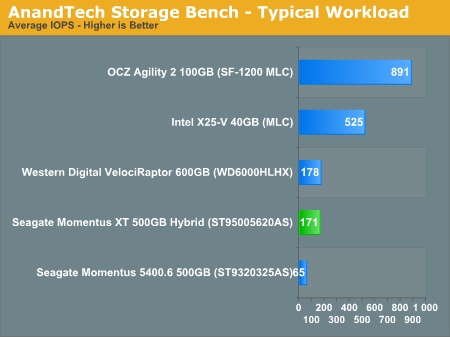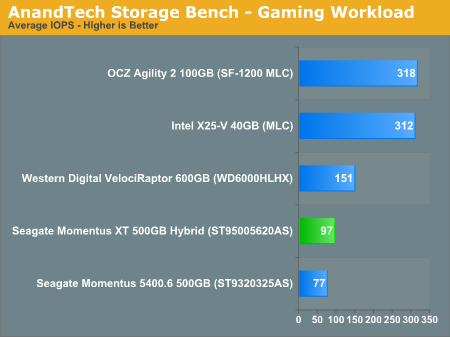Seagate's Momentus XT Reviewed, Finally a Good Hybrid HDD
by Anand Lal Shimpi on May 24, 2010 9:31 AM EST- Posted in
- Storage
- SSDs
- Seagate
- Momentus XT
- Hybrid Drive
- SSHDs
AnandTech Storage Bench
The first in our benchmark suite is a light usage case. The Windows 7 system is loaded with Firefox, Office 2007 and Adobe Reader among other applications. With Firefox we browse web pages like Facebook, AnandTech, Digg and other sites. Outlook is also running and we use it to check emails, create and send a message with a PDF attachment. Adobe Reader is used to view some PDFs. Excel 2007 is used to create a spreadsheet, graphs and save the document. The same goes for Word 2007. We open and step through a presentation in PowerPoint 2007 received as an email attachment before saving it to the desktop. Finally we watch a bit of a Firefly episode in Windows Media Player 11.
There’s some level of multitasking going on here but it’s not unreasonable by any means. Generally the application tasks proceed linearly, with the exception of things like web browsing which may happen in between one of the other tasks.
The recording is played back on all of our drives here today. Remember that we’re isolating disk performance, all we’re doing is playing back every single disk access that happened in that ~5 minute period of usage. The light workload is composed of 37,501 reads and 20,268 writes. Over 30% of the IOs are 4KB, 11% are 16KB, 22% are 32KB and approximately 13% are 64KB in size. Less than 30% of the operations are absolutely sequential in nature. Average queue depth is 6.09 IOs.
The performance results are reported in average I/O Operations per Second (IOPS):

Under typical multitasking workloads that aren't write intensive, the Momentus XT performs much like the new VelociRaptor. This isn't a typical notebook drive at all. We're still far away from even the cheapest SSDs though.
If there’s a light usage case there’s bound to be a heavy one. In this test we have Microsoft Security Essentials running in the background with real time virus scanning enabled. We also perform a quick scan in the middle of the test. Firefox, Outlook, Excel, Word and Powerpoint are all used the same as they were in the light test. We add Photoshop CS4 to the mix, opening a bunch of 12MP images, editing them, then saving them as highly compressed JPGs for web publishing. Windows 7’s picture viewer is used to view a bunch of pictures on the hard drive. We use 7-zip to create and extract .7z archives. Downloading is also prominently featured in our heavy test; we download large files from the Internet during portions of the benchmark, as well as use uTorrent to grab a couple of torrents. Some of the applications in use are installed during the benchmark, Windows updates are also installed. Towards the end of the test we launch World of Warcraft, play for a few minutes, then delete the folder. This test also takes into account all of the disk accesses that happen while the OS is booting.
The benchmark is 22 minutes long and it consists of 128,895 read operations and 72,411 write operations. Roughly 44% of all IOs were sequential. Approximately 30% of all accesses were 4KB in size, 12% were 16KB in size, 14% were 32KB and 20% were 64KB. Average queue depth was 3.59.

Crank up the sequential writes and you lose the benefit of the 4GB of SLC NAND on board the Momentus XT. It still delivers competitive performance with the X25-V thanks to the latter's limited write speeds, and it is faster than a conventional 2.5" drive as read operations still come off the NAND, but you don't get VelociRaptor performance out of it.
The gaming workload is made up of 75,206 read operations and only 4,592 write operations. Only 20% of the accesses are 4KB in size, nearly 40% are 64KB and 20% are 32KB. A whopping 69% of the IOs are sequential, meaning this is predominantly a sequential read benchmark. The average queue depth is 7.76 IOs.

As a benchmark that's bound by sequential read performance it's not surprising to see the Momentus XT not pull ahead here. Remember that we're limited by how quickly data can be streamed out of a single NAND device so you don't see a huge improvement in performance.










120 Comments
View All Comments
enderwiggin21 - Tuesday, May 25, 2010 - link
Almost 40% more at idle and ~33% more at load is most definitely "considerably more."Under 10% and *then* you're into the statistically insignificant category.
svend - Monday, May 24, 2010 - link
Will the NAND still be effective when using the XT with an encrypted partition/filesystem? What affect would encryption have on the performance of the XT?GullLars - Monday, May 24, 2010 - link
Thumbs up to seagate for the sollution, the one used in previous hybrids that relied on the OS was not very effective.I actually made a thread on XS forum a couple of months back discussing a sollution like this, a HDD with a NAND read-only cache using LBA read pattern mapping as caching algorithm.
In my discussion, i suggested using 8-16GB (1-2 dual plane dies) MLC ONFI 2.x NAND on a single channel for lower complexity. This would give up to about 7500 4KB random read IOPS (30MB/s), and 90-180MB/s sequential read (for cache hits). At a cost of roughly 2-3$/GB + a NAND controller, the added price tag would be around 25-50$.
I think this could be interresting for higher capacity 3,5" "black" drives as well as high-performance high capacity notebook HDDs.
auhgnist - Monday, May 24, 2010 - link
Hybrid HD seems similar to Intel Turbo Boost technology, in terms of both SSD capacity and NAND type, except that Turbo Boost allows certain level of control such as caching only data accessed some pre-given programs. Any idea how these two compare in terms of performance?joshv - Monday, May 24, 2010 - link
I mean seriously. Add another 4GB of RAM and let the OS do the caching. Sure, it won't help with boot, but for everything else it should be a lot faster than some SLC NAND on the HD.enderwiggin21 - Tuesday, May 25, 2010 - link
Or how about both?mpx999 - Monday, May 24, 2010 - link
It would be interesting to compare performance of hybrid SSD with software-based flash read cache schemes. There are basically two of them for Windows: built-in Readyboost and third-party eBoostr. Other operating systems have even better mechanisms, eg. Solaris has L2ARC caching scheme for reads and ZIL for writes.http://blogs.sun.com/brendan/entry/test
http://dotnet.agilekiwi.com/blog/2008/10/how-eboos...
Both Windows caching mechanisms can work with either USB sticks, or memory cards in built-in readers. Second option is very interesting as it means SLC flash cards can be used.
I suspect hardware controlled read-cache as implemented in this hybrid drive will totally beat Windows software -based mechanism in one important application: running virtual machines. It's because hardware cache operates on disk blocks so it doesn't matter it these blocks are from base machine or virtual machine, while software Windows mechanisms rely on file-based statistics, so they only speed up base machine. One would have to create separate cache for each VM to get speedup. Btw. software-based Solaris caching doesn't have this limitation.
vision33r - Monday, May 24, 2010 - link
It's nowhere need a true SSD in performance and just offers the cheap space of a spindle drive.The the same has having a SSD internally and carrying a spindle drive externally.
Once SSDs gets cheaper, solution like this will be less interesting.
I expect SSD prices to drop from $99 for a 40GB to like $60, then we'll see 200GB SSD for like $150 or less.
jmv2009 - Monday, May 24, 2010 - link
I don't think writing through the ssd is that important, as it can be effectively cached using the main memory of the system. Only for sustained writes >1 Gb this would become slow if the caching works well.nsravan - Monday, May 24, 2010 - link
The site had not much activity since you went on vacation. So I took one too :)